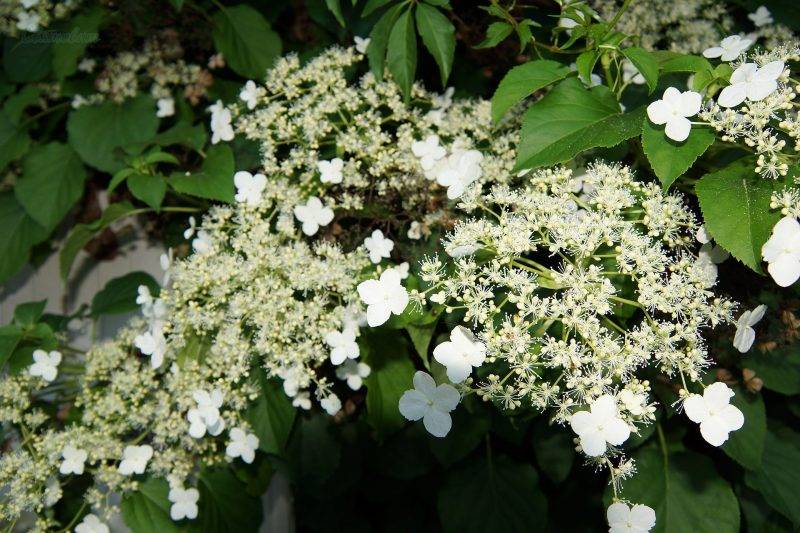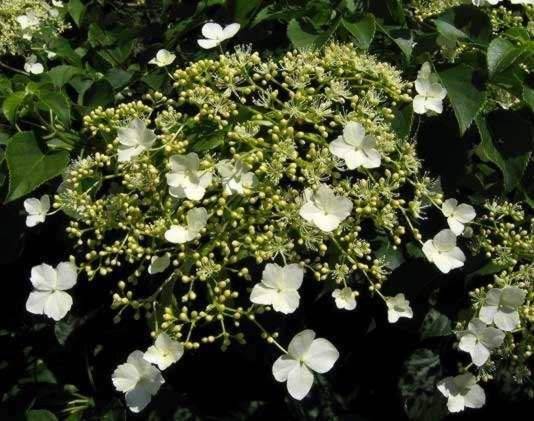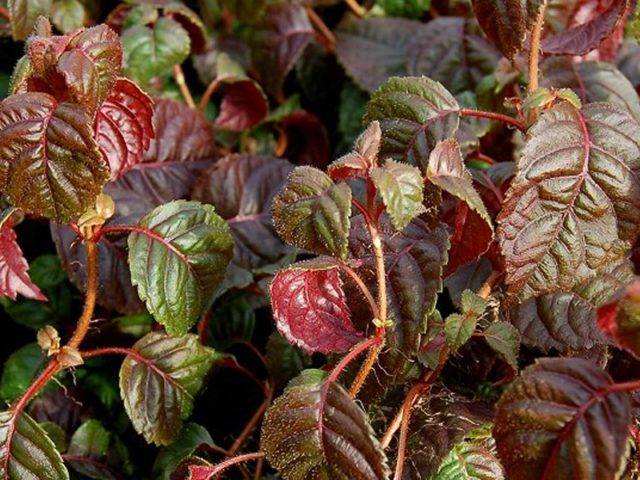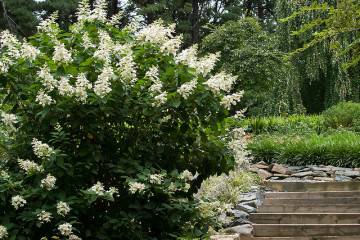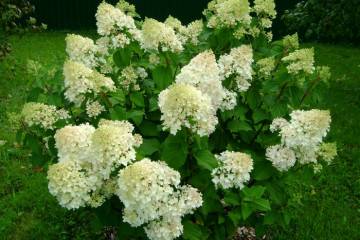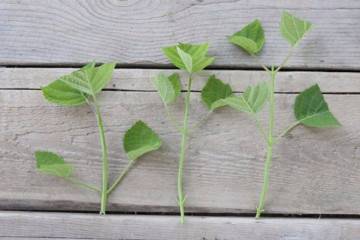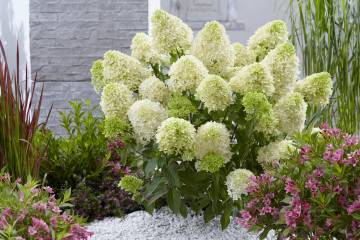Hydrangea petiolate or climbing, curly liana
Content:
The petiolate hydrangea belongs to a unique species of garden hydrangea, which differs from the tree-like and paniculate perennial varieties. The petiolate species has no stem. The plant does not need complicated care. It is enough to systematically water the flowers, clear the flower bed of weeds and loosen the soil. Pruning helps maintain the attractive appearance of the perennial.
Origin and appearance
The territory of East Asia is considered the birthplace of perennial culture. Hydrangea is widespread in Japan and China. Also, a perennial can be found on about. Sakhalin and the Kuril Islands. In recent years, liana has become popular in Russia as well.
Under natural conditions, the plant grows in coniferous forests, entwining massive stem parts of spruce and fir. The adventitious aerial roots of hydrangea allow perennial crops to reach heights of more than 24-25 m. The assimilation of nutrients is carried out through the main root, which is located on the ground, and through the shallow aerial root system.
The leaf plates of the petioled hydrangea are naturally endowed with heart-shaped outlines. Their diameter can reach 10 cm. The length of the petioles, covered with short hairs, reaches 8 cm. The upper area of the green mass is colored in darker tones than the lower one. The stems are up to 5 mm thick. With the onset of autumn, the foliage turns bright yellow, and by mid-October it falls off.
Petiolate hydrangea during flowering pleases the owner of the plot with the formation of large inflorescences. The diameter of each inflorescence of the corymbose type often exceeds 19-20 cm.In the central part there are small flowers, and in the extreme areas, white buds are formed, the diameter of which can reach 3 cm.
Thanks to its beautiful large buds and lush green mass, climbing hydrangea has gained wide popularity among gardeners.
Popular species and new varieties of petiolate hydrangea: description and characteristics
Among the most popular varieties of perennial culture, there are such species as:
- Miranda is a curly hydrangea, characterized by the presence of notches along the edges of the leaf plates. The edging of the foliage can be painted in cream or yellow shades. The height of the bushes reaches 600 cm. Inflorescences, the diameter of which is within 2 cm, are painted in white tones. The pleasant scent of flowers spreads throughout the garden area. The flowering period lasts from July to early September. Miranda does not need to prepare for the winter cold. However, when growing a perennial in harsh climatic conditions, it should be borne in mind that the tips of the shoots, in the absence of shelter, can freeze slightly;
- Cordifolia is a climbing hydrangea, the height of which reaches 150-170 cm. The variety is distinguished by its slow growth. The annual growth does not exceed 8 cm. The length of round-shaped leaf plates is within 80 mm. The upper region of the leaf blades is painted in green tones, and the lower one strikes with an almost white surface. The advantages of Cordifolia are winter hardiness and the presence of immunity to a variety of diseases;
- Petiolaris is a climbing hydrangea, a liana that is often used by landscape designers for landscaping the local area. The height of mature bushes can reach 25 m. Liana quickly braids the trunk of trees and covers the surface of the soil. Inflorescences of the corymbose type are painted in white tones;
- Take e Chance is a weaving hydrangea that is winter-hardy and able to climb a trunk. Leaf plates can be edged with white stripes or completely covered in white. If you properly care for the crop, you can achieve abundant and long-lasting flowering;
- Winter Surprise is a creeping hydrangea, the height of which is within 180-200 cm. The flowering period lasts from mid-May to the end of June. The petals are painted in snow-white tones. The green mass turns red closer to autumn. The variety is frost-resistant, therefore, when growing flowers in warm climatic conditions, no special shelter is required for the winter;
- Silver Lining is a liana whose height exceeds 400 cm. The adhesion to the support is due to the presence of aerial roots. In the early years, the growth of the perennial is slow. You can adjust the length of the vine and its width using systematic pruning. Round leaf plates are colored green. Along the edges, the foliage is bordered with silvery stripes. White inflorescences are of the corymbose type. Their diameter reaches 20-25 cm. The variety must be planted in well-lit areas. The plant grows well in drained, fertile and moist soil.
Planting climbing hydrangea outdoors
It is recommended to plant liana-shaped hydrangea in open ground in mid-April or early May. When choosing a zone for planting bushes, it is worth giving preference to areas well protected from gusts of wind. It is better to choose slightly shaded areas so that direct sunlight cannot cause burns to the green mass. It is especially important to follow this recommendation in regions where abnormal summer heat often occurs.
The soil for planting hydrangeas should be loose, moist and acidified. It is advisable to pour a self-prepared soil mixture into the flower bed, which includes:
- peat;
- sand;
- fertile land.
Step by step process
- In the selected area for planting seedlings, it is necessary to dig up the ground.
- Put a seedling in the hole and spread its roots.
- To deepen the roots of the seedling into the hole. The root collar should not be buried more than 3 cm, which will make it possible to avoid slow growth.
- The soil at the planting site must be tamped. It is impossible to leave voids in the near-stem circle, which will prevent the occurrence of a moisture deficit near the roots.
- After planting the seedlings, water the young plants abundantly. The area of the trunk circle is mulched with a layer of peat.
Flowers should be planted in a soil well warmed by the sun's rays. Do not rush too much, because night frosts can destroy young plants. Experts in the field of floriculture recommend giving preference to loose soil, which contains a large percentage of humus. The soil must be breathable and permeable.
If desired, you can use nutritious garden soil. The area of the trunk circle should be mulched with red high peat, leafy soil or compost, which has managed to decompose well. If the soil in the area is too heavy, mix it with a little coarse sand. Alkaline soil is acidified with a small amount of peat or with special preparations like "Acid +".
Reproduction
To propagate hydrangeas, you can use one of the methods:
- seed;
- by cuttings.
To plant seeds of a perennial crop, you will need to fill the pots with fertile soil. Seeds are sown on the surface of the ground and sprinkled with a small layer of soil. The soil is abundantly moistened, and the container is transferred to a well-lit area. Next spring, young plants can be planted in a permanent place in the flower bed.
To use the vegetative method, you will need to pre-prepare green cuttings with one internode. The length of the cuttings should not be less than 8 cm. Spacious containers are filled with fertile soil. Cuttings are planted in the ground for rooting. The soil should be moistened daily, and it is best to cover the container with a layer of film, which will need to be removed for 5-10 minutes. every day for the purpose of airing.
Hydrangea care
To achieve the lush flowering of a branched hydrangea, it is necessary to provide the perennial with proper care. Below are the main recommendations of specialists in the field of floriculture regarding the features of caring for petiolate hydrangea.
- Systematic watering. The plant belongs to the category of moisture-loving crops, so soil moisture should be not only regular, but also abundant. Under each bush of the plant, you will need to pour 35-45 liters of water. It is advisable to use settled rainwater for irrigation. In dry weather, the bushes are moistened every 2-3 days. On rainy days, it is enough to pour a bucket of water under the bush once every 10 days (if the amount of precipitation is low). Mulching the soil around the trunk allows for a longer evaporation of moisture.
- Fertilizing promotes abundant lush flowering. Fertilizers must be applied every spring and summer. The first feeding is applied in the spring during the active growth of the crop. For this purpose, it will be necessary to add a solution to the ground, which includes 25 g of urea, 35 g of superphosphate, 35 g of sulfuric potassium. At the time of the beginning of the formation of buds, you will need to apply fertilizer, which contains 55 g of superphosphate and 35 g of potassium sulfate. The listed components dissolve in water. The same fertilizer can be used to feed flowers at the end of summer. Also, do not forget about the need for an annual rash of 3-4 kg of compost under each bush (you can use overfilled manure). To strengthen the shoots of the plant, the soil should be systematically moistened using a weak solution of potassium permanganate. This procedure also helps prevent the occurrence of various diseases. After August 25, it is unacceptable to add any top dressing to the soil, which will allow the hydrangea to have time to lignify by the winter cold.
- Timely pruning makes it possible to prevent compaction of shoots, thickening of bushes and loss of attractive appearance. Incorrect procedure can lead to a lack of flowering. The acquired shape after pruning can persist for a year. It is worth remembering that you can cut off shoots only in those vines whose age has reached 3 years. The procedure must be carried out in early spring. Annual branches should be shortened so that only 3-4 pairs of buds remain on them.
Preparing for winter
Stalked hydrangea belongs to the category of frost-resistant plants, therefore, when grown in favorable climatic conditions (for example, in the Moscow region), the construction of a special shelter is not required.
Growing a petiole species on the territory of Siberia, there is a possibility of freezing of young bushes.That is why it is worth taking care in advance of preparing for severe frosts. To do this, you need to lay the branches on the boards. From above, the shoots are covered with a layer of spruce branches or dry foliage.
Diseases and pests
The petiolate hydrangea is most commonly grown as a ground cover plant. Ornamental culture is not susceptible to disease. However, against the background of improper care, problems may arise, namely, the defeat of the bushes:
- chlorosis, manifested by lightened foliage;
- gray rot that occurs against the background of improper watering or an excess of nitrogen fertilizers that are applied to the soil.
To cope with chlorosis or gray rot, it is enough to adjust the mode of watering the bushes, the frequency of fertilization and spray the perennial with Bordeaux liquid.
There may also be an invasion of the culture of spider mites, aphids and thrips. It is important to identify the presence of pests on flowers as soon as possible and treat the hydrangea with an insecticidal agent.
The petiolate hydrangea is a popular variety of liana, which, with proper care, can delight the owner of the site with abundant and long flowering. The creeping bush is unpretentious and everyone can plant and care for climbing hydrangea in the open field.



